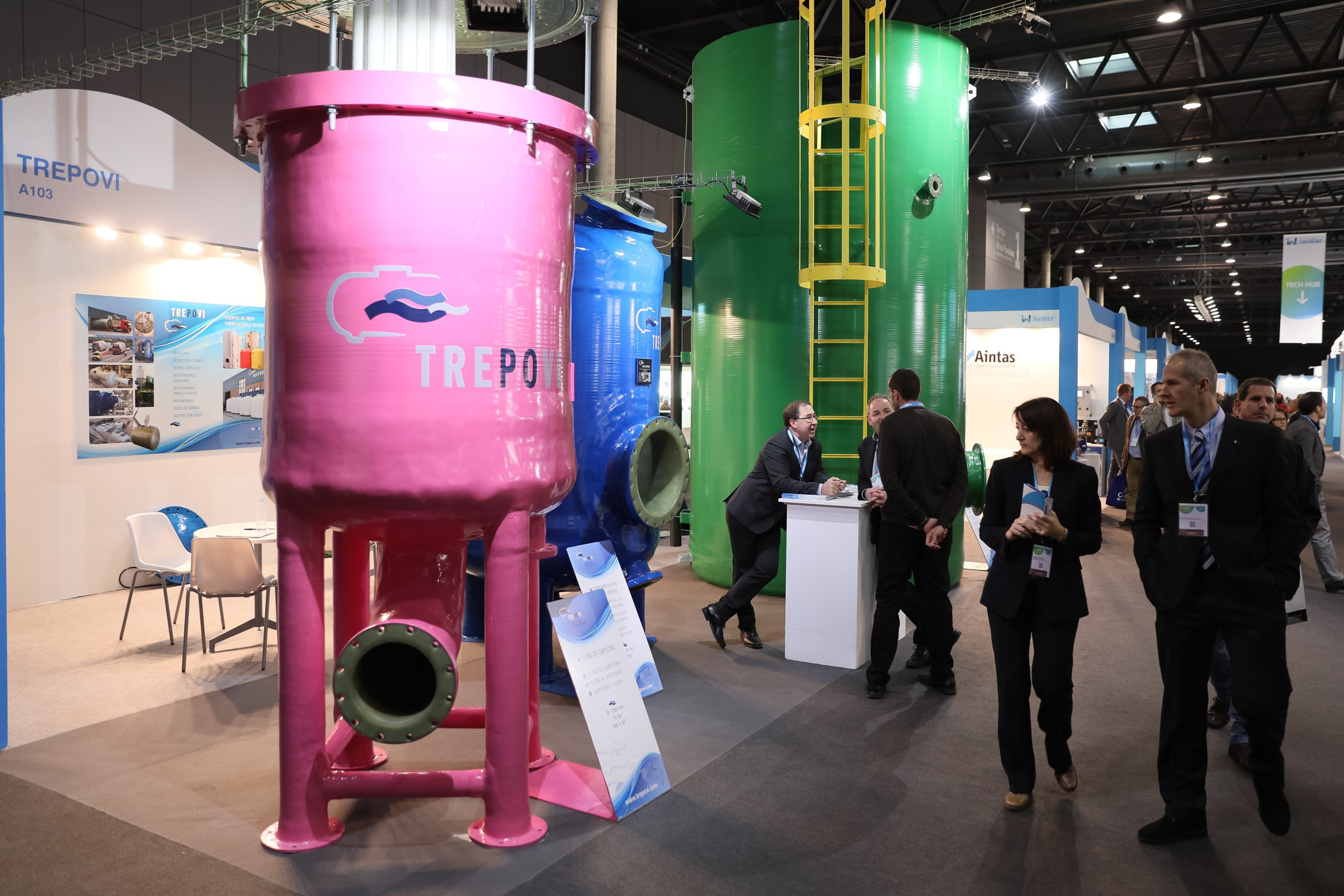The iWater Forum has had the important contribution on infrastructures of Xavier Leflavie, director of the Environment of the OECD, PhD in Social and Political Sciences from the University of Cambridge and specialist in water economics and finance.
Leflavier has led or participated in OECD publications on water management for growth, water allocation, water pricing and infrastructure financing, and urban water management. Is particularly interested in innovative ways of water management and the management of water policy reforms. Its work essentially covers the countries of the OECD, BRICS and countries of the former Soviet Union.What role do infrastructures play in the development of countries?A recent report from Oxford University, commissioned by the Global Water Partnership and the OECD, has established for the first time how investment in water security contributes to sustainable growth and development. The report Securing Water, Sustaining Growth establishes that river basins that have developed, either benefit from reliable water flows, or have invested in water infrastructure (essentially storage to mitigate drought and flood risks).
This is illustrated by the chart below: dots represent river basins. The green dots are the more developed ones, while the red ones are the least developed. River basins stuck in the bottom right corner require foreign financial assistance to kick start investment in water security that can sustain growth.
Figure 1. Economic growth, hydrological variability and investment in water security
Source: Sadoff C. et al. (2015), Securing Water, Sustaining Growth, report of the GWP-OECD Task Force on water security and sustainable growth
Is it a priority issue for governments?Some governments acknowledge that investment in water security is investment in development. Several countries, including Korea and the US, have promoted investment in water security as part of their recovery package after the 2008 crisis. The US President-elect also mentioned investment in infrastructure and in water infrastructure in particular, as a priority for the coming years.
Financial needs in the water sector are tremendous, to build new infrastructures; operate, maintain and renew existing ones; and adapt existing assets to shifting circumstances, in particular to a changing climate. Financing water security is an issue in both developed and developing countries.
Water, however, competes with other infrastructure sectors and policy areas to access public funding (transport, energy, education, health…). Therefore, it is critical to harness other sources of finance, which can secure appropriate levels of investment in water security. This is the ambition of the Roundtable on water finance, launched by the OECD and several partners. The Roundtable brings together water people and a range of financiers (debt and equity; public and private) to find out concrete ways to channel the available financial resources towards investment in water security.
How do you regard the financing of the infrastructures?
The first point is that there are opportunities to avoid building future liabilities. Typically, building property on flood plains only increases future risks of flooding, which will translate in needs to finance flood protection. In the Netherlands, property developers are requested to assess how water-secure new properties will be. Similarly, impervious surfaces increase runoffs in cases of heavy rains. Several cities around the world – Philadelphia is a good example - encourage green roofs, which capture a significant share of rainfall, or build permeable pavements, which allow rainwater to percolate through the ground and recharge aquifers, thus minimising runoff and the need to collect and treat it.
Where new infrastructure is required, it is important to acknowledge that water infrastructures are very diverse: large dams to store water; flood defence; irrigation canals; water supply and sanitation networks; infrastructures to collect rainwater… Water infrastructures can be grey (i.e. built in concrete) or green, meaning strategically planned networks of natural and semi-natural areas with other environmental features designed and managed to deliver a wide range of ecosystem services. Some are large (dams, centrally piped networks); others are small (e.g. distributed systems that collect water from rooftops and use it locally).
Different types of infrastructures have different opportunities to raise finance, both public and private. For instance, Australian households invest in rainwater harvesting and distributed treatment capacity, to shield their property from the risk of droughts. In so doing, they contribute to water security. Obviously, financing irrigation canals or dams is a radically different business.
The new Recommendation of the OECD Council on water recommends that governments aim for the greatest social returns to investment, for example through:
• Exploring options that can minimise current or future financing needs while addressing trade-offs and exploiting synergies between policy objectives and between short and long term challenges;
• Taking stock of existing assets, maintaining them, looking for efficiency gains;• Developing strategic financial plans that match financial resources with policy objectives, and ensure affordability for vulnerable segments of society, including through ad hoc targeted measures; and
• Setting up an independent review of efficiency and cost-effectiveness of investments.
Is there money available?
The report Water: Fit to Finance , commissioned by the OECD and the World Water Council, has confirmed that there is no shortage of money. Savings have accumulated in both developed and developing countries, providing commercial banks with financial capacities. Institutional investors are looking for opportunities to invest in projects that yield stable return in the long term. This is exactly what the water sector has to offer. The problem is: how to attract available sources of finance to invest in water security, in the face of competition with other sectors (e.g. renewable energy)?
Should the financing for carrying them out be public or private?
My understanding is that the opposition between public and private finance is misleading. The issue is rather how to allocate risks and revenues to make the best use of available (public and private) sources of finance.
Renewable energy was able to attract huge amounts of finance, because it provides returns on investment. We still have to invent ways in which investment in water security, which yield significant economic gains, translate into revenue flows and investment opportunities.
This is an issue, because water is not a mere commodity, and water security can be considered a public good. This is a nut that needs to be cracked, however, because public finance alone will not be able to cover the investment needs in water security at scale.
The Roundtable on water finance, already mentioned has the ambition of hosting such a discussion between the water community and financiers, to better understand the respective roles of public and private financiers.
What is the involvement of different administrations?
Central, sub-national and local administrations have a role to play to make the best use of available resources.
The report Securing Water, Sustaining Growth argues that not all investments in water security equally contribute to sustainable growth. The most beneficial investments, from a sustainable growth perspective, are sequenced along strategic pathways. Therefore, administrations in charge of economic development need to be involved: they set development trajectories, which need to factor water security in. Local governments also have role in designing and sequencing investments in water security.Public finance has a critical role to play and Treasury sets priority to allocate budgetary resources. Similarly, the policy framework for investment must be conducive to private investment.
Investment needs in water security also depend on decisions made by other administrations, which can generate further water-related risks or investment opportunities: agriculture, transport, urban development. All these administrations need to factor water security in, and work in a coherent way.
Which European countries have the best infrastructure? And the worst?
It is difficult to qualify the "best infrastructures". A country can rely on well-developed assets, but are they properly maintained and renewed? Can they adjust to climate change?
The Netherlands, arguably a global champion in water security, recently called on the OECD to assess its performance in this area. Obviously, the Netherlands enjoy a very sophisticated combination of infrastructure and institutional arrangements, which has effectively kept Dutch feet dry for centuries. But our report Water Governance in the Netherlands identifies issues about how fit this combination is for future challenges.
Most European countries face issues regarding financing the renewal of existing infrastructure, adaptation to a changing climate and adjustment to shifting priorities and regulations. Think of more stringent health and environmental regulations. Think of the improved awareness of emerging pollutants, found in water bodies.
The European Framework Directive and related pieces of regulation provide a robust framework to assess these needs and trigger policy action. Whether investments will materialise on time essentially depends on the capacity to combine diverse sources of finance, through a proper allocation of risks and revenues.
What do you think of the IWATER Exhibition?
The combination of a water event with other events on urban development makes a lot of sense. The combination of a trade exhibition and conferences is valuable as well.
In the future, the different ingredients can be better articulated to produce an exciting and fruitful environment.
The location and venue are great. Barcelona has a lot to offer when it comes to water security and sustainable growth.
1) Sadoff C. et al. (2015), Securing Water, Sustaining Growth, report of the GWP-OECD Task Force on water security and sustainable growth
2) The text of the new Recommendation is available here (http://www.oecd.org/environment/resources/water.htm ).
3) Winpenny J. (2015), Water: Fit to Finance?, report of the High-Level Panel on financing infrastructure for a water-secure world
4) OECD (2014), Water Governance in the Netherlands. Fit for future challenges?, OECD Publishing








